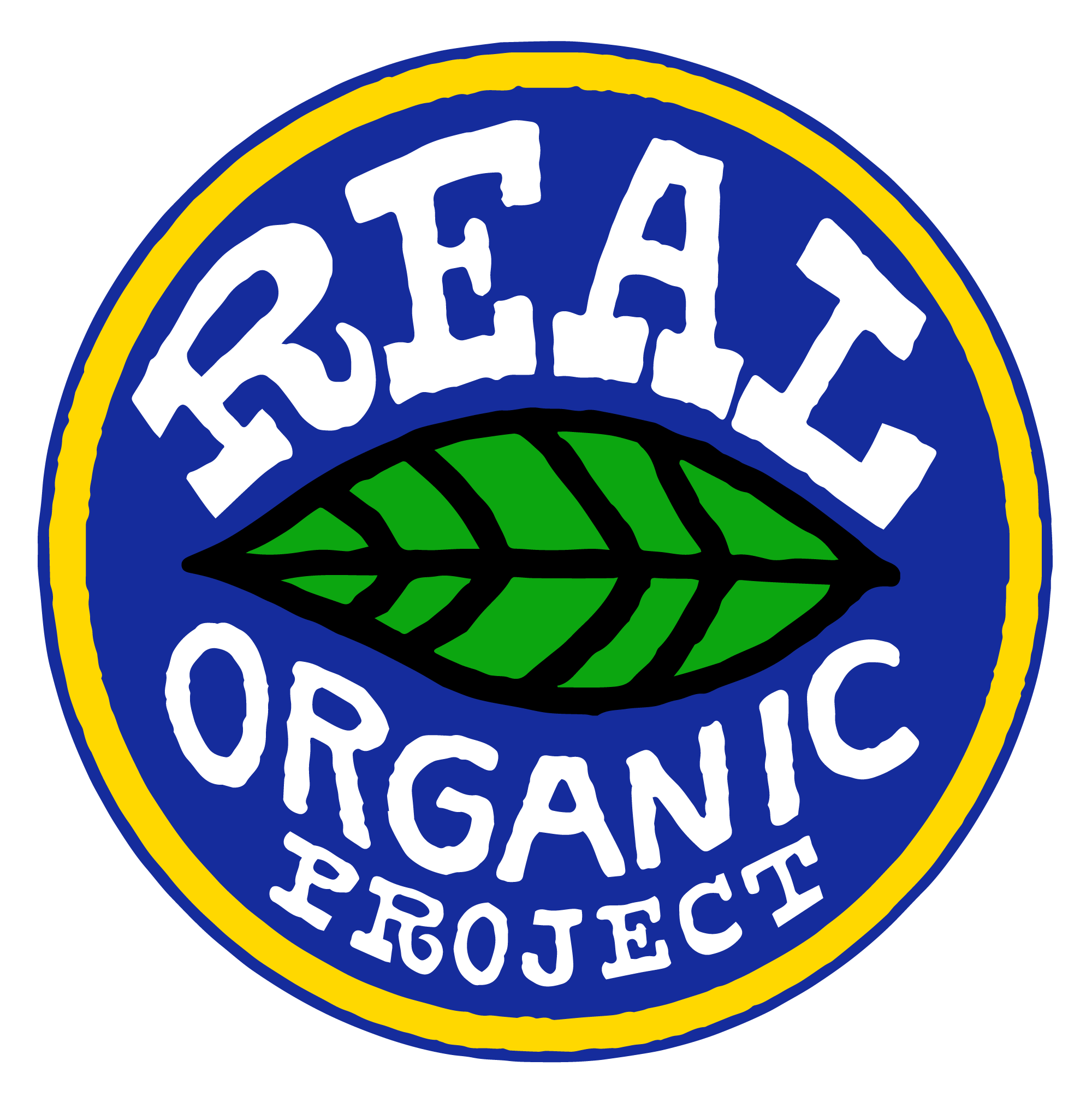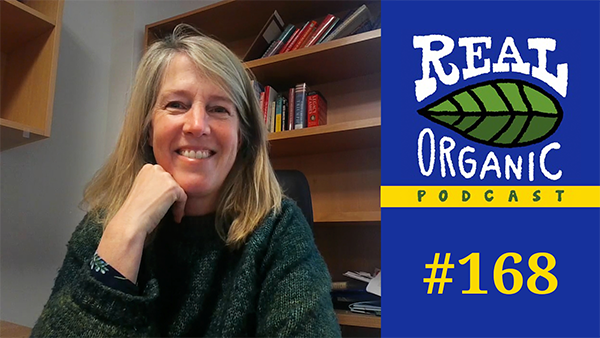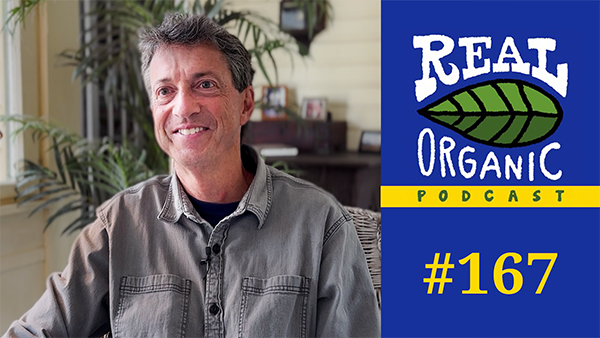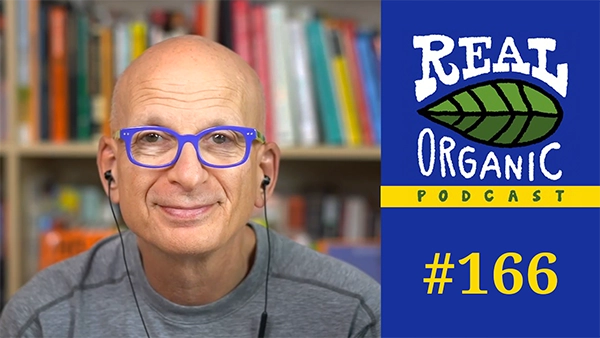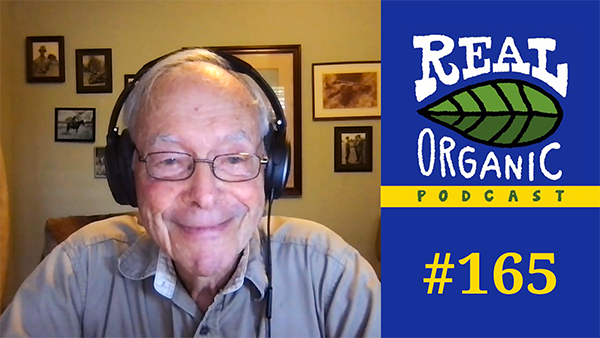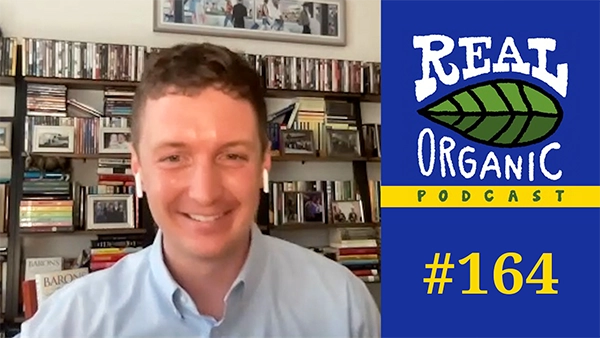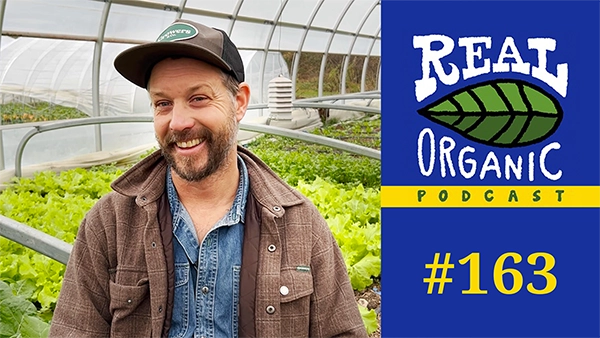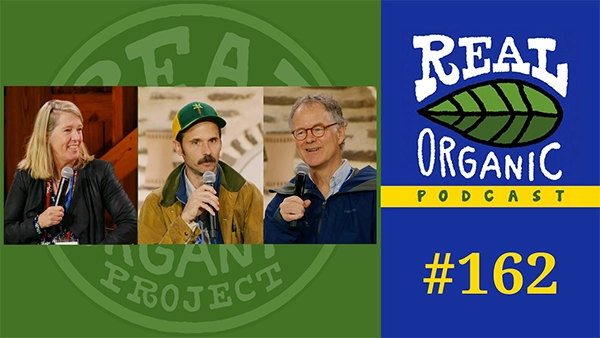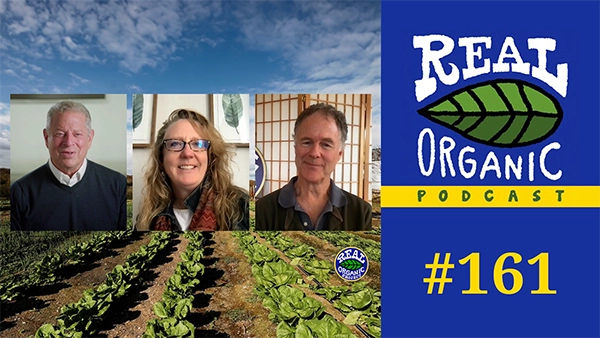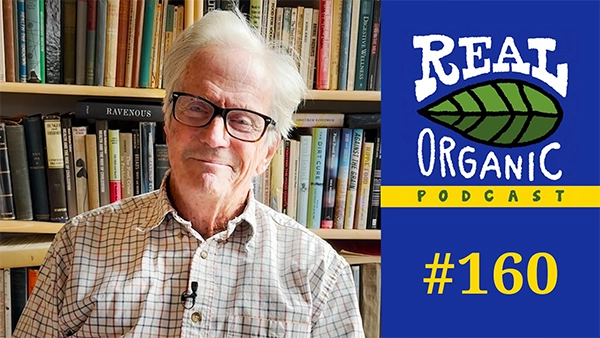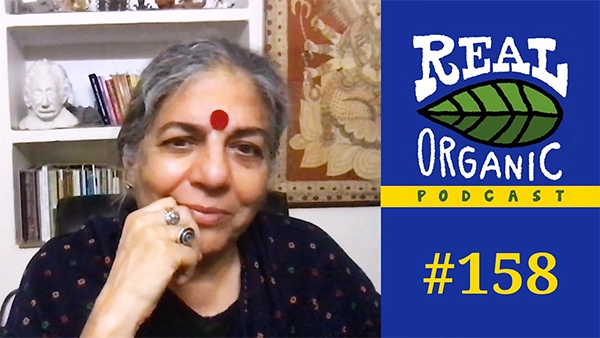Episode #159
Errol Schweizer: Consolidation, Greenwashing, And The Growing Myth Of Local Food
Welcome! You can subscribe and download episodes of our show through your favorite podcast app.
You can also subscribe to receive the video version of each episode on our YouTube channel.
Our Errol Schweizer interview has been edited and condensed for clarity.
Dave Chapman interviews Errol Schweizer:
Errol Schweizer 0:00
Welcome to The Real Organic Podcast. I’m talking today with Errol Schwetzer. Errol, I’m pleased, I’m pleased to have this conversation. I’ve been listening some of your interviews with other people on your podcast the Checkout, which I recommend to people. You’ve really interviewed a lot of great people. One of your focuses is about the consolidation in the retail space of food, and one of your focuses about labor practices. I’d like to talk about labor practices another day. But today, I’d like to talk about what’s happening with consolidation monopoly in the food space, and in your case, particularly in the retail space. So, can you just give us a little bit of background about how you came to be interested in this? How you came to be in the food space?
Errol Schweizer 1:02
Yeah, sure. I was biology major when I was in college. I’m a graduate of the New York City/New York State public education system and realized I did not want to be pre-med. I’d been working part time to, pay the bills as a deli clerk, grill cook, all the campus food service stuff. And then, I discovered we had a little independent volunteer run food Co-Op on campus. At the time, I was also going through my own little awakening, thinking about food and society. It was really involved at the time in the 1990s upstate New York hardcore punk scene, which for those folks who are familiar with music, know that we had a very vibrant scene in the 90s. And that politicized me. I started hanging around the food Co-Op a lot. I went on the five year plan, it took me a while to graduate – I barely graduated. I didn’t really know what I wanted to do so I just started working jobs, lots of jobs like retail, wholesale, the community organizing around food and environmental justice and tenant organizing. I did every kind of weird blue collar job you can do when you’re jjust trying to pay the rent: landscaping, construction, et cetera.
Errol Schweizer 2:27
I was also an EMT for a while, I did 2000 hours as an EMT when I was up in Binghamton. I eventually found my way to Whole Foods, and I thought I was just going to stay there for a couple months, or maybe a couple of years at most, especially since I had done a bunch of retail already a lot of grocery. I was kind of iffy on it, but I ended up staying there, mostly because I really loved the people I was working with. My first or second day on the job, I was talking to my assistant manager, “what’s up Howard Schwartz, how you doing out there, Howard”? And I was asking Howard, I was like, why do you do this? Why do you work for this big company, and you’re dealing with all this bullshit every day. He was like, “you know, man, I’m just here to feed the people, I want to feed the people as much organic as I can”. And I looked at him and I was like, “is this clown, like, telling the truth?” And he was. I got to know him really well. He was really committed, which is what happened with a lot of the folks from my era of Whole Foods, they were really committed to expanding access of Organic and natural and healthy foods.
Errol Schweizer 3:30
And I’m not going to talk about our leadership, and our CEOs, and you know, all the things that, you know, they say – I’m going to talk about the people I worked with, and a lot of them are still my closest friends. You know, they love what they do, and they kept me kept me there for too many years. I was at Whole Foods for 14 years, I moved up and around, I was asked to apply to jobs after a while, I was asked to apply to be a regional grocery director in the northeast, which is the New York region. I did okay there by implementing a whole bunch of the merchandising practices that made the company money by also getting to sell better food and partnering with a more diverse array of suppliers. So I was asked to apply to be on the national team, and I was on the national team for nine years. We had three program pillars that we did, we negotiated EDLP – everyday low price programs – with large multinational CPGs to make sure we’re getting the best price for our customers.
Errol Schweizer 4:26
We had a really vibrant and diverse category management program for launching new products primarily from smaller and mid sized brands that we work really closely with local foragers to find smaller companies and grow them into national partners. And we did that with dozens of companies. Then we had a national promotions program to put more stuff on sale and make sure that we were just putting things at a value price. Our average price in our department at the time was $3.49. So, I know there was a lot of PR about how expensive Whole Foods was and continues to be, but our department, which was Center Store, really carried the company in terms of the gross margin by pricing things reasonably, and by selling a lot of Organic foods, a lot of ethically sourced foods.
Errol Schweizer 5:21
So, I left Whole Foods in 2016 – I was pushed out in a wave of layoffs that happened in that era. We saw a lot of people coming in from larger companies, Target, Walmart, Home Depot, etc – this is about 18 months before Amazon acquired it. I could probably go into great detail about what business practices led to Whole Foods being acquired by Amazon, but since then, I’ve worked for at least a dozen retail competitors to Whole Foods, primarily co-ops, and independents. I’ve worked with probably two dozen emerging and startup CPG companies, primarily Organic, primarily, women and people of color owned. I’ve also stayed active in my community, in Food Policy Board, food access work – particularly during COVID-19 – and I have a podcast called The Check Out. I was asked to be a Forbes contributor, which I’ve done now for a couple years, so, I appreciate being here, and I’m a big fan of Real Organic Project, we have a lot of friends in common.
Dave Chapman 6:28
So this is really interesting. I also have a long relationship with Whole Foods. We started selling to Bread And Circus a long time ago.
Errol Schweizer 6:37
That’s before my time.
Dave Chapman 6:38
Yeah. And then they got acquired, of course, by Whole Foods. Interestingly for us that was, for my farm, that was not a bad acquisition, because Bread And Circus was a tough nut to deal with as a as a supplier, and Whole Foods was nicer. It was moving into that period, your period when Whole Foods was working pretty hard to bring in local producers, and frankly, most stores were. They were following the lead of Whole Foods, so it was interesting to see; Hannaford sent a film crew here and so did Shaw’s. You know, everybody wanted to show that they were getting local, and Stop and Shop loved us. That’s all gone. That’s all gone. None of those people are interested in local, they certainly aren’t interested in regional. They’re pretty much national buyers now, and I’m just curious: does that ring true for you? Do you see that shift?
Errol Schweizer 7:39
Yeah, well, I mean, the continued consolidation of the industry, which we could talk about, but also the fact that they’re not getting as much public pressure as they were 15-20 years ago. I also think there was a generation of us in the industry who were pushing for that, who just felt like we could do better. But also, we were sort of bored by by the status quo. You know, I don’t mean to be flippant about it, because the status quo is also devastating to the environment, unfair to workers, and not really good for the consumer either. So, I think there was a movement afoot in the industry that I think has really tailed off. I think for a while there were enough of us in retail who were pushing the envelope to make retailers, I’d say a leader, because I think some retailers have always been leaders, especially a lot in independence and co-operatives. But, to get even the larger organizations to play more fairly, and at least try to be a bit more sustainable, which was really difficult with these internal cultures and their their profitability needs nd just general conservativism towards, you know, any kind of progressive food system change. I think that’s really gone now. You know, you see a lot of PR, a lot of greenwash, but not a lot of substantive actions. They say: oh, we saw a lot more healthy food, we saw a lot more fresh food, and then show pictures of random commodity growers.
Errol Schweizer 8:57
There’s not really a substantive effort, which is something I detailed in a recent interview I did for the Guardian about certain on shelf attributes like “Local”, and just how sort of commodified and abstract that’s become. It has no real meaning. Not to say that it had a meaning when I was working there, I’m saying that we were trying to assign it something substantive through the work we were doing with suppliers, with supply chains. We were really rebuilding them from scratch, primarily as to change the trajectory of the American food system. I don’t say that lightly, because a lot of us put a lot of time and effort and blood and sweat into that, and weren’t always successful. I would say, right now, we’re seeing the fact that on an institutional level a lot of us weren’t successful because the institutions themselves refuse to change after a certain point. We saw a big reaction, particularly driven by Wall Street profitability needs, but also though just general malaise. Like: oh, we can’t really make much more money on this, so why are we trying so hard, we’re not getting that much pushback from customers, and we could just give them just enough to keep them happy and quiet. And, you know, we could do a little PR to keep the activists off our back. So, just in general, I’m lot more skeptical about the role that retailers can play in improving the food system right now.
Dave Chapman 10:23
All right, let me ask you a question, because you said something I actually hadn’t considered, which is that a lot of this movement towards buying Local, which was not just greenwash. I mean, I saw the chains in the northeast were absolutely scrambling to buy Local, to open their doors to local suppliers. And, and I thought, wow, things are looking up! This is great to see that the food system is changing. And I think you just suggested that change was primarily coming from the people who are working within the system, within the companies, that there was a group of people, fairly activist, motivated people, who said: we can do better, let’s buy local food from farmers, as opposed to just this pressure from eaters from consumers to say this is what we want. You’re saying, that actually, this change was being led by a fairly enlightened group of mid-level managers within these companies?
Errol Schweizer 11:30
Yeah, I mean, a lot of us came up through the organizations. We started out as clerks, and we started out in food co-ops or farmers markets – I’ve worked on farms, I’ve done, stuff outside of traditional retail. We had folks who came from traditional retail, bigger grocers, and like, eurgh, I hated that, I want to do something different. I’m going to give a couple shout outs, I’m going to give a shout out to David Lafferty who’s still at Whole Foods, who’s still in my mind, and bucking the system, keeping it real. I’m going to give a shout out to Jamie Nestle, who is now the chief merchant at By Right – she was also in my generation of merchandisers at Whole Foods. I’llgive a shout out to Kara Rubin, who took the Northeast region grocery reigns after I left, and took it to all new heights in terms of percent of products that were Organic, and the amount of Local and diverse suppliers that they were supporting for well over a decade – Kara was actually pushed out the same month I was. And then we had dozens of local foragers around the company, the foragers were always the first wave of layoffs at Whole Foods. I’ll just say that they were great for PR, they brought in these people that were all heart and soul, they weren’t merchants, they were more like social workers for emerging brands and farmers.
Dave Chapman 12:43
Errol, let me interrupt just so you can explain, because people don’t know. What’s a forager in Whole Foods?
Errol Schweizer 12:49
A forager was just someone who’s scouts the marketplace in a given radius looking for local brands, local products, local producers. So, it’s different than the job that I did as a category merchant grocery director where I was responsible for the profit and loss, I was responsible for the financial performance. And I figured out, I learned how to achieve those numbers, those financial targets through merchandising better food. Local foragers didn’t necessarily have an easier job, because they were tasked with finding a lot of that stuff. But then, they had to work with people like me to merchandise them into our stores, into our supply chains. So, Harv Sing in NorCal is a pretty well known local forager, or Denise Briley in Seattle, who I think was pushed out recently by Whole Foods. These are folks who were just, like I said, all heart and soul – they they gave so much of their energy to developing these local supplier relationships, which I think is really contrary to how much of retail works day to day. Which is why I feel they’re kind of, not a dying breed, but there’s just not a lot of them, and they’re mostly used as PR these days because they’re not put in a position of power or influence. They’re more just put in a position of public relations. I think that was a little different 10 or 15 years ago, because we had a lot of them. They were all over the place and they were bringing in a lot of great stuff.
Dave Chapman 14:13
Yeah, okay. So you mentioned a lot of people who were pushed out. How did that happen? Why was the corporation stepping away from this Velvet Revolution? This group of people who were bringing something?
Errol Schweizer 14:35
You know, I think there was a lot of things changing in Whole Foods. There was a lot more demands from shareholders for profitability, like bottom line EBIDA as a publicly traded company. They were demanding tighter GNA, general administrative spending, they were demanding that company labor budgets would be lower – at the time in the early 2000s Whole Foods was spending 19%, 19 cents of every dollar on labor, which is about five to six points. Most of the retail is – that’s probably 2x what Walmart spends, or Trader Joe’s spends. So you know, I’m not saying it was a worker’s paradise, it was a lot of hard work. And it was not a unionized workplace so there were no guarantees, there are no pensions. But it was a it was a great place to work for the time being. And because of those financial pressures, those pressures on margins that were driven by the fact that mainstream retailers like Kroger, Walmart, Albertsons, Trader Joe’s, Stop and Shop, had jumped headfirst into Organic foods. But, they plugged them into their supply chains, with their supplier relationships and their philosophies which were much more about efficiencies and economies of scale. When you have a company that has 2000 stores, it’s a very different economy of scale than a company with two stores, or 20 stores, or 200 or 500 stores.
Errol Schweizer 14:35
So, it’s different types of supplier relationships, different suppliers, they pushed Organic certifiers to conform to their needs. For instance, you saw a lot more hydroponic products coming. Hydroponically grown produce, those are meant to service the big channel retailers. You saw Organic dairy that was being sourced from CAFOs as opposed to small family farms; that milk was going towards these efficiencies, these economies of scale at these larger retailers. But what this also meant was that it pushed the price threshold down. So not just for the consumer, the consumer expected a cheaper price to get milk at Walmart versus milk at Whole Foods, or Wild Oats or milk at the River Valley Co Op. So they expected that. But that shit flows downhill. And what that meant was that it was lower prices for farmers, and then it was also lower labor budgets, which is the largest fixed expense of any business is labor. Lower labor budgets at a retail the size of Whole Foods meant a few things – it meant that we had to shrink down the full time/part time ratio. I started at Whole Foods at full time and I got benefits within six weeks – that changed drastically in the next 15 years. At this point, I would say the full time/part time ratio is maybe 40/60. It’s very rare to hire anybody at full time in stores. Anybody who’s full time has probably just been there a long time and has managed to survive. The other thing they started doing was consolidating teams, and just piling more work and more responsibilities on a smaller number of people.
Errol Schweizer 17:22
In terms of my role in merchandising – because there were greater margin demands, there greater demands on labor – for us, we have to deliver more to the bottom line every year. Not just in terms of dollars, but in terms of absolute rate, the gross margin. So, from the time that I started at Whole Foods until I left, our gross margins went up by two and a half points, which is pretty unprecedented because the net profit margin of most retailers is maybe between one and 2% usually. So, to push your gross margin up by 2.5 points in your center store, your largest department, puts a ton of pressure on your suppliers, it puts a ton of pressure on your team to perform and deliver. And I’ll say this, I delivered til the very last day that they walked me out. I was an all star the year they fired me. And the reason why I got pushed out was because I didn’t like the changes that were being implemented in the company. I didn’t like the layoffs, I didn’t like seeing friends and colleagues of mine getting pushed out of their jobs, I didn’t like this talk about moving to less full time work, I didn’t like the fact that they were taking power away from the stores, and I didn’t like the fact that the company itself wasn’t executing the commitment to supplier. So, if you negotiated a program with the supplier, it was 50/50 whether it even showed up in stores, because there just wasn’t accountability from the regional executives to fulfill those obligations. It’s very different than say, like, a retailer Co-Op, where you know, the stores are contracted with the co-op service provider, like a Wakefern, to fulfill those contracts.
Errol Schweizer 18:57
For us, we were seeing a reluctancy, but they were happy to take the money from the suppliers. So I was very vocal about that stuff, as proud New Yorker’s do, I always had an open big mouth. I have no filter, and that doesn’t always go well down here in the south, where everybody expects me to be polite and just sort of, you know, live and let live and get by. No, not this guy! So, I was told in no uncertain terms to seek happiness elsewhere. We actually parted and it was fine, it was time for me to go. But it wasn’t just me, it was a whole generation of folks. I say what we have now is a diaspora of Whole Foods employees from that era, who, despite the public narrative, despite some of the statements and public behaviors of some Whole Foods executives, are actually wonderfully committed to improving the food system, are highly skilled, and come from a culture that put the customers and the suppliers first.
Errol Schweizer 18:57
Serve people in order to make your financial targets, in order to keep your lights on, in order to stay business as opposed to managing the bottom line and managing the financials, pleasing shareholders or pleasing the company owners with higher margins every period, every quarter. Managing to their expectations as opposed to the expectations of you know, your stakeholders. Like I said, suppliers and customers. So, it’s a very different mindset, and there’s a lot of wonderful people out there. In fact, I would say the Good Good Purchasing Program, which is a set of food purchasing standards for the public sector, which is now used in over 60 public institutions across 15 cities, was co-developed by Whole Foods. It was co-developed by trade unionists, teamsters, NGO, and food policy access experts, and then folks from Whole Foods who actually had experience in implementing those standards at scale in the marketplace. So, once those scales hit the public sector, they were road ready, they were able to be implemented because they’d been tested in the private sector by stores like Whole Foods, or Natural Grocers, or any one of dozens, hundreds of food co-ops around the country.
Errol Schweizer 21:16
I think it’s this not really well known dimension, that there are just so many wonderful, talented, heartfelt, Organic, natural product leaders out there that came out of retail. Then, obviously, we love farmers, we love farm workers, we love grocery clerks, but then you have this other the sector of folks who are still out there doing the good work. I like to speak to them, not say on behalf of them, but just to make sure that folks understand that is where a lot of the product that we all consume, a lot of the income that farmers have, that they’ve maintained in retail, are due to those efforts, and not just from a couple of superstar executives, or celebrities, etc. So, I’ll get off my soapbox now.
Dave Chapman 22:03
No, no, no, it’s really interesting! People go to the store and it’s like going to Disney World. It’s entertainment, or they they appreciate the amazing apparent array of choices that they have.
Errol Schweizer 22:17
It’s a bit of an illusion of choice. We could talk more about that.
Dave Chapman 22:22
Yeah, I’d like to talk about that. So, one of the things that I think is Whole Foods catches a lot of heat.
Dave Chapman 22:30
And rightly so!
Dave Chapman 22:33
Well, I want to say for transparency, Whole Foods still a big customer of mine. I’m one of the last farm standing as far as that goes.
Errol Schweizer 22:45
*laughs* I’ll call those folks up in North Atlantic if they give you a hard time.
Dave Chapman 22:49
That’s right. *laughs* But, a lot of good things did come out of Whole Foods in terms of how it was genuinely different from the other chains. The co-ops were fantastic, the co-ops have been fantastic, their what we want – I know that all of these stores are hard to compete with for old co-op. So first, I want to go to the Amazon buy out of Whole Foods, and then I want to go to why is it that we keep losing? Amazon came in, and they came in because because Whole Foods was vulnerable, right? Their economic was-
Errol Schweizer 23:33
So, here’s the dynamic that happened since 2013. In 2013, Whole Foods’ stock price peaked, because that, I feel, was like the penultimate timeframe when Whole Foods was taking active leadership role in the food system, whether it was supporting GMO labeling, attempting – not necessarily successfully -attempting to open stores, in lower income communities or what they’re calling food deserts, which, I hate that term. The desert is a very diverse place, especially having lived in Texas long enough, having been out west, not a food desert. Anyway, Whole Foods had been doing a lot of stuff with local, and because there was this mainstream move towards Organic, Whole Foods started feeling price pressure from other chains, and then margin pressure from Wall Street. So, what they did was they doubled down on value pricing, saying we’re gonna sell lower priced items, we’re going to launch more 365 Private Label, we’re going to compete on price with these retailers that are two or three XR size. And, what that did was that put pressure on the gross margins.
Errol Schweizer 24:36
Like I said earlier, it’s a race to the bottom when you start competing on price as opposed to quality, assortment, relationships, and values. So value and values are kind of mixed up a little bit when it comes to retail, and not to say that we don’t need to lower prices – I could get to that later because I think price architecture is something I’ve written quite a bit about. For now, I’ll just say that that focus on price and competitive positioning just cascaded this whole other set of side effects which continue to hurt the gross margins, because when you go from selling all this product at or above your gross margin, which in the case of Whole Foods is like 40%, to saying we’re going to switch half of our assortment to a 20% gross, that means the other half needs to be up 60% to make up for that. So, by doubling down on price, they managed to sell a small percentage of high volume items cheap, but the vast majority of their prices actually went up. This is something that as a merchant, I documented every quarter. I said: all this talk about you guys lowering prices, by pushing us to lower prices on these high volume items, it’s the waterbed effect, or the seesaw. You’re actually raising prices, and you’re dropping tonnage, you’re lowering volumes on all this other stuff.
Errol Schweizer 25:52
I put these numbers in front of them every quarter because this is what I was responsible for, I was responsible for gross margins, I was responsible for top line sales. We never missed in my team, we did whatever we could. We sacrificed our health, our family life, our sanity, to keep the lights on, and we were proud of what we stood for. But, it got worse and worse, the full time/part time ratio, the pressure on wages, benefits, and just general working conditions, just having to work 60 hours a week, for years, in order to accommodate these business demands. So the fact that some of us started getting real salty *laughs* And, what happened was, within the 18 months from when I left until Amazon bought them, they brought in a bunch of folks from the conventional grocery world who figured that they could just apply their learnings and conventional grocery to Whole Foods. But all it did was it double down on that dynamic of pressuring the margins.
Errol Schweizer 26:53
And once you start pressuring the margins, and you are selling a lower priced item, and you don’t generate more volume, you’re actually hurting your top line sales too. So, when you drop your blueberries from 4.99 to 2.99, it’s a $2 savings per pack, that means you have to sell, I don’t know, what, 40%? 60%? more blueberries to make up for that. In terms of units, that wasn’t happening. So, you saw a decline in the top line and bottom line, which affected the stock price and made them very vulnerable. And, they had been having backdoor conversations with a number of retailers, with Albertsons, with Amazon, for years in the potential buyout situation, and I think that the penultimate goal of a lot of so called libertarians is consolidation. They’re only a libertarian until they sell out and then they want to become king.
Errol Schweizer 27:40
I think what you see there is that the biggest fish that was willing to pay, which had a lot of similar market positioning, which was Amazon who targeted middle-to-high income, had a lot of premium positioning, but their organizational philosophy was very much to where Whole Foods was going. This direction was to really put pressure on workers, particularly in the blue collar jobs, to put a lot of pressure on the merchandising teams in terms of the margins, and you see a lot of turnover in those staff positions. It was kind of an easy marriage when – it wasn’t really a surprise to those of us that know. Like, oh, yeah, that makes sense. Besides the fact that the Westlake store in Seattle, which is one of Whole Foods nicest stores in Seattle, is literally across the street from Amazon HQ, and was catering Amazon for years. So there was always some personal relationships anyway.
Errol Schweizer 28:33
I think a lot of the PR that came out at the time was dead wrong. A lot of folks were saying how good it would be for food access and expansion of Organic, and how great it would be for Whole Foods. What I don’t think people realize was Amazon was buying 450 fulfillment centers. They were buying hub and spoke into all these other communities and they were buying all this customer data that they now had access to. So, they could apply it to food just like they moved from books to hardware, to electronics to apparel, and they’ve dominated and strip mined pretty much every other category that they’ve ever touched. Now they’re moving into food. I actually gave an interview to Ken Roseboro from Organic Non-GMO Report. I was trying to give some benefit of the doubt. I said, “Yeah, this probably shows that they’re interested in Organic, they bought Whole Foods, and they didn’t go after, you know, any number of other retailers”.
Errol Schweizer 29:31
But you got to remember, these guys are really tough employers. They are brutal on their suppliers. They’re brutal on their workers. And that’s been proven true. There’s always campaigns to unionize Amazon, they’re pretty well known for their turnover and the really adverse working conditions. When you look at Whole Foods now, like I said, there’s still some great people there, but when you go into stores, I swear that half the time the employees look at you like they hate you! They don’t want to be there because those jobs are just so different. There’s just a lot more turnover, the pressure is much higher. The pay is actually pretty good on an hourly basis at Whole Foods, but it’s rare that you can get full time work. So even if you’re getting 25 bucks an hour and you’re working 20 hours a week, you need another job to survive. And so that is created-
Dave Chapman 30:19
They want hold people to part time, so they don’t have to pay benefits.
Errol Schweizer 30:25
It’s partly on the benefits, but it also just overall keeps the labor dollars lower, because you’re also increasing the turnover, meaning you’re always hiring folks at lower rates than your incumbent staff, which are at higher rates with great benefits. It’s a very intentional policy. So, it’s unfortunate, because there’s still a lot of good stuff they do, and there’s still a lot of folks internally there who aren’t necessarily on the same page as Amazon in terms of food product and quality and such. I’m not going black and white here; I think there’s there’s still some some positives, but also, I’ll just emphasize, I’ve worked for probably a dozen of their competitors since I left, so.
Dave Chapman 31:06
Okay, so one of the things that we see here is that there’s this constant pressure – it appears to be a financial pressure – for things to get worse. In my opinion, this is better for shareholders, but it seems to be worse for everyone else. Now-
Errol Schweizer 31:10
It’s the Wall Street model.
Dave Chapman 31:28
Yeah! So, we see Amazon and Whole Foods are just one consolidation, but obviously Albertsons and and Kroger’s-
Errol Schweizer 31:43
Whole Foods and Amazon is a small consolidation, it’s still less than 3% of all grocery volume.
Dave Chapman 31:48
right?
Errol Schweizer 31:48
They got way too much PR: it was not as significant and the fact that the press was saying, oh, amazon is going to be competing with Walmart and Kroger now was laughable.
Dave Chapman 31:55
Yeah.
Errol Schweizer 31:56
Online they do. Online, yes, Amazon is 50% of all online sales.
Dave Chapman 32:01
Right
Errol Schweizer 32:03
But not brick and mortar.
Dave Chapman 32:04
Right. Of course, those online sales are going to just keep exploding, I suspect, over the next 20 years.
Errol Schweizer 32:12
Yeah well, in terms of grocery, there’s a lot more market share from Walmart, which is a much bigger fish, much more dangerous. Then, there’s a lot of regional players; like, I live in Texas currently, and HEB has the best online e-commerce program in the industry. People love HEB, so it has very high rankings. But just in general, Amazon knows what they’re doing with e-commerce, they do these prime days, etc. They just haven’t been able to figure out brick and mortar, and they haven’t been able to bridge this grocery-omni channel, as we call it in the industry. So, it’s sort of stop and start with them. Not to say that it isn’t dangerous and that every other retailer shouldn’t be watching them closely.
Dave Chapman 32:52
Okay, so I’m Joe Citizen here, and all of this is happening almost invisibly to me, that there’s a tremendous amount of consolidation going on. How many companies are controlling four fifths of the, the groceries in America?
Errol Schweizer 33:15
It’s about six. Yeah, six or seven. Between Walmart and Kroger, it’s close to 40%. When you add in Albertsons, it’s about 45%. Ahold, which is stop and shop, and Hannaford, which you mentioned, it’s 50%. So, whatever that is, whatever I just said, they’re now adding Costco, you get to 60% – although I do have a soft spot for Costco, they treat their workers better, and they’re essentially a warehouse, you’re paying wholesale prices. But their chicken program out in Nebraska is terrible for the environment, by the way. Anyway, when you have six or seven companies, you’re close to 60% of the grocery industry. What that means is 60 cents of every grocery dollar spent in this country goes to like six or seven companies, right? And that just gets more consolidated over the decades.
Dave Chapman 34:02
Each one of those would be over 6% of the national grocery bill, which would be considered a monopoly.
Errol Schweizer 34:11
Yeah, monopolies, I think the saying goes: all monopolies are local. So, on a local and regional level, you have a lot of different types of monopolies. In California, for instance, Safeway, Albertsons, and Kroger. Albertsons and Kroger kind of split LA-SanFran like 50/50. So, between the two of them, it’s usually 40% market share between two these two companies, and then you have a lot of independents in California – a lot of great chains, a lot of smaller chains. When you go to a place like Denver, King Soopers is, I think 60% market share. King Soopers is a Kroger division. When you’re in the Cincinnati Metro, Kroger is dominant in the Cincinnati-Northern Kentucky area, that’s their heartland. But when you go to Florida, it’s Publix country!
Errol Schweizer 34:56
They’re 60 plus percent market share in most of the major cities. When you’re in Texas, HEB has 50% market share in Austin. Walmart is 20% – so in Austin, which is supposed to be weird, and this alternative progressive blueberry-and -the-red-soup BS, blah blah blah. There, 70% market share, 70 cents of every grocery dollar goes to two companies: HEB and Walmart. New York City kind of defies the odds? Like, there’s no grocery chain that’s more than like 5 or 6% – it’s because they have so many independents, Mom-and-Pop family businesses, and also service co-ops like Wakefern and Allegiance and Key Food – they’re independent owner co-ops. And so on and so forth, like, Seattle as another example is 50+% market share between Kroger and Albertsons. The Twin Cities is 50% market share between Cub Foods, Target, and Walmart.
Errol Schweizer 35:49
So on a national basis, though, Walmart is still the center of gravity in the grocery industry. They have monopoly control of hundreds of metro areas, mostly smaller towns and cities primarily in the middle of the country, but also drifting out into the upper Midwest in the Southwest, and the Southeast. Walmart has a deleterious impact on every aspect of the grocery industry, we talk about pricing – you may not be shopping at a competitor Walmart, but your grocery store competes with somebody who competes with Walmart, guaranteed. What that means is there’s price pressure on what their retail prices are, there’s pressure on their wages downward. Because Walmart, even though they’ve raised wages, still does not pay a living wage in any Metro. Living wages in most metro areas are north of 50 grand, how many grocery stores can say that they, on average, pay their clerks $25 an hour, 40 hours a week, 52 weeks of the year? Probably not too many. That’s why there’s 75% food insecurity in the grocery industry, that was a study that came out about Kroger.
Errol Schweizer 36:57
All these pressures come though from Walmart. So, we talk about the Kroger-Albertsons merger, they admitted it, like: we need to merge so we can compete with Walmart. They’re not lying, that’s probably the only thing they’re not lying about. The problem starts with Walmart and how Walmart has gutted the economies of hundreds of towns and cities. It’s gutted food systems. Just think of the section effect of how much Walmart’s supply chains are buying from around the world. They’re a huge customer of just about every major brand, and many smaller brands, many small and midsize farms, but particularly larger farms. Walmart is just a huge presence in the grocery industry, and you can’t have any conversation about grocery unless you get Walmart 30% of the time for 30 cents of the dollar.
Dave Chapman 37:46
Okay, I’m Joe Citizen, and you just told me that there’s this tremendous consolidation into a small number of hands. Why should I care?
Errol Schweizer 37:57
Oh, you should probably care because you’re paying 30 to 40% more for groceries this year than you were in 2019. The problem with the inflation narrative is they keep talking about inflation in single digits because it’s the CPI, the Consumer Price Index, which is the price of what you paid for today versus what you paid for this day last year. What that does is it clouds the fact that there has been high single digits to low double digit CPI increase now for three years, meaning what we’re paying for the same item now is 25 to 30% higher than what we were paying in April of just 2019. The reason why that happened is because of the consolidation in the grocery industry. So, this isn’t to say that there weren’t supply chain issues- there were, I’ve written about that. Just in Time inventory systems, which prioritize the needs of shareholders and finance departments over the needs of consumers, are what cause much of the supply chain bottlenecks, because everybody in the supply chain was holding very little inventory to keep cash off their balance sheets.
Errol Schweizer 38:57
What that did was when there was a shock, or multiple shocks within the pandemic, everybody at one started scrambling for more inventory, so stuff got a little scarce, there was a lot of holes on grocery shelves. And then, there were other material issues in the supply chain, there was a shortage of pallets, there was a shortage of semi-conductors, there was shortage of corrugated cardboard, it hit pretty much everything. So, there was a bit of pressure on prices at first. But, due to the consolidation, particularly – I mean, this consolidation is at all levels of the food system, I’ll just say that. But the two that we’re going to talk about now are the consolidation in packaged goods, consumer packaged goods CPG, and then at retail. There’s something called price signaling.
Errol Schweizer 39:44
Most of the time, nobody wants to raise prices because there’s too much competition, so if you get a list price increase, you try to absorb it if you’re a retailer, or just moderate it or spread it out over time and across a lot of products. But because everybody started getting these supply chain bottlenecks, which were pushing up some of their input costs at once: price signaling is essentially wink wink nod nod – oh, you’re raising prices, i’m raising prices. Oh, they’re raising prices, i’m going to raise prices. Oh, let’s all raise prices now! And then, what happened was they started raising prices, resulting in higher profit margins because they were able to raise prices above the rate of cost increases, so they’re essentially skimming a little extra off the top. Retailers are doing the same thing – retail is saying, oh, we’re getting cost increases wink wink nod nod. There’s only a handful these retailers so like, oh well, Ahold is raising prices and Albertsons raising prices, so think I got a little bandwidth to raise prices too.
Errol Schweizer 40:45
Likewise, the publicly traded retails were able to skim a little off the top to the point where within the first six to nine months of the pandemic, despite all this stuff about hazard pay increases, which most of these retails didn’t really want to do or do for very long – shareholders made bank! The Walton family alone made $8 billion in windfall profits. Within the first 12 months of the pandemic, Amazon and Walmart both had profits go up between 40 and $90 billion. Sorry, don’t quote me on the exact number, but it was a lot more than us mere mortals can really comprehend. Kroger was cutting billion dollar stock buybacks and dividends to their shareholders because, not only were their profit dollars skyrocketing, but their margin rates. Remember what I talked about earlier, you’ve got the fixed and the variable; my fixed rate at Whole Foods went up over the course of 10 years because of margin progress and how we bought and sold product. Kroger, and a bunch of these other retailers, and a bunch of these CPG companies were able to increase their fixed rate by a half point here, a half point there, by skimming, additional profit, by raising prices above the rate of costs.
Errol Schweizer 41:56
So, when I first started writing about this about a year and a half ago, I didn’t get really too critical. I think people understand that I know my business well, but it really didn’t have much of an effect. Like, I had to write three or four articles before people started really going, oh, it’s clicking. However, there’s an economist, Isabella Weber, who was writing about it before I did. She’s out of UMass Amherst, so she’s in your neighborhood, so to speak. She was called stupid by Paul Krugman, she was like really trashed by all these mainstream economists because she was documenting something that she calls Seller’s Inflation. So, everything I’m talking about in the food industry, Professor Weber was documenting across all sectors, and showing how the profit of the price inflation now was coming from sellers because of their ability to leverage crisis to raise prices, right?
Errol Schweizer 42:46
So, what happened in the food industry was all these prices went up, margins went up – the margin rate in the grocery industry doubled. Usually, it’s like 1%-2%: it went up 4% in 2021 and early ’22. Really high, unprecedented margins for the grocery industry, these are net margins, or profit margins that is. What happened then was the shareholders started making windfall profits. Shareholder profits have been at the highest rates for the last two years since WWII. They peaked at like 16% one quarter, they’ve been between about 13% and 15% for the last couple quarters. They’re coming down a little bit now because there’s price pressure on supply chains and consumers are starting to say: yeah, forget about it, we’re not going to take any more of these price increases. Customer traffic is down, volumes are down, etc. But in the meantime, shareholders make bank, we saw the highest rate of stock buybacks ever.
Errol Schweizer 43:40
Prior to the Reagan administration, stock buybacks were considered stock price manipulation. Maybe that’s the case, we need to think about that because stock buybacks, what they do is they then create an increase in the stock price for the company. So, let’s do the math here. Supply chain crisis, cost increases, price increases, then higher than the cost increase, meaning we’re getting higher margins. Higher margins means we can cut more shareholder buybacks and dividends to our investors, meaning you’re raising prices, you’re taking money out of the pocket of consumers to pad the portfolio’s of investors. I call this Robin Hood in reverse, with all due respect to one of my favorite bands, Bad Religion, it’s one of their songs, but Robin Hood in reverse essentially multinational CPG retail companies padding stock investor portfolios and their executives portfolios too by raising prices to consumers.
Errol Schweizer 44:38
What you’re seeing now is because we’re having, these price increases over and over and over and over again – our consumers are buying less food, insecurity has skyrocketed particularly due to the ending of SNAP pandemic benefits and, upcoming soon, pandemic WIC benefits. So, food insecurity is at least 17%, but over 27% of 18 to 44 year old skip meals: people are eating less. So, what you’re seeing grocery retailers, and the CPG brands are all saying this, our volumes are down. So, their volumes are either negative or their volumes are tracking below the rate of inflation, which means they’re essentially down, even though their stock prices are up because the diamond dynamic I just talked about. Their prices keep going up and the gross margins had been going up; on this point, a lot of them are seeing a lot of margin pressure ,and the gross margins are coming down a bit. But either way, it’s been a bonanza in the food industry, and the party is just about over because I think consumers in particular are like, this is crazy, everything’s so damn expensive now.
Errol Schweizer 45:41
There’s this website called Retail Watchers that somebody turned me on to, where you could look at receipts. People are documenting receipts from 2019 to 2022, and in certain retailers like Walmart, their Great Value brand, which is the country’s largest private label brand, prices were up 30%-40% on many items. Albertsons prices on some of their private label items like Signature and Lucerne were up 70%-100% in that three year timeframe. So, when you hear the media narrative saying: oh, well, CPI has slowed down to 3.6% or whatever 4%. That is the price you’re paying today on the same item on average, as last year, but that doesn’t measure the damage to your wallet that has been inflicted over the last three or four years. It also doesn’t measure the fact that the way that CPI translates into CPG, consumer packaged goods, companies’ rate of price increases has continually outpaced the rate of inflation every quarter since the beginning of the pandemic, sometimes 2x the rate of inflation. This was a study done by Nielsen IQ, which is, for those of us in the grocery industry, the largest syndicated data – for us it’s like gospel. CPG companies have at times been 50%-75% higher in the rate of price increase than the Consumer Price Index, which is the “measure of inflation”. So when you asked me why consolidation is bad, what are you paying for groceries?
Dave Chapman 47:05
So, you’re saying just on the simple economic basis, which is how people now consider antitrust – well, are prices going up for consumers? You’re saying-
Errol Schweizer 47:16
Well, that’s the Robert Borl, Ronald Reagan School of antitrust, yes.
Dave Chapman 47:20
Exaclty.
Errol Schweizer 47:20
That’s very different from Robinson-Patman and the New Deal.
Dave Chapman 47:25
So you want to talk about that just for a moment? What was the traditional model of antitrust?
Errol Schweizer 47:32
Robinson-Patman was meant to break up the oversized purchasing power of large grocery chains. It was particularly targeted at A&P, the great Atlantic and Pacific Tea Company, which at the time was 12% *laughs* market share in the 1930s. I’m laughing because Walmart’s literally 27%, between Walmart and Sam’s. So at the time, these two senators Robinson and Patman thought they could break up A&P by putting pressure on them to not have advantageous pricing relative to their competitors. So, not negotiating exclusive deals or exclusive items, or putting pressure on suppliers so that supplier to give A&P a low price but then make up on their margins – remember what I said earlier about the seesaw effect – that goes for companies too, they have to charge higher prices to everybody else. So, Robinson-Patman came at a time when the grocery industry was very diverse economically – something like one quarter of all grocery employees owned shares of the companies they work for. There were more black owned groceries than there are today! In fact, name one grocery chain that’s black owned, I could think of one and I’m in the grocery industry. Just think of that for a minute, let that stew. But the other point about this is that Robinson-Patman’s reinterpretation happened starting in the late 60s or 70s. In between the New Deal and the 60s and 70s – what you had was the birth of agribusiness.
Errol Schweizer 49:00
So, after the New Deal, you had a new administration of the Eisenhower administration, they came in and said: well, we have all this infrastructure for food processing leftover from WWII that we fed our troops with and a lot of it’s owned by these private enterprises. What if we just let these private enterprises feed the country, let them take over the role of “government” in assuring that there was a cheap, safe, convenient, abundant food supply. So, in the 1950s, you saw the rise of agribusiness. Not just what we usually think of agribusiness like factory farms and monocrop agriculture; agribusiness extends throughout the supply chain, the leading end of it being retail. And so you saw a CPG companies which are the consolidators of raw materials between the farms and the retailers, the growth of big CP. General Foods, Kraft, and Nabisco all came out and really consolidated in this time – a lot of them had existed previous WWII and had been selling product to the US government for the war effort. These companies honed that infrastructure and leveraged that with the blessing of the USDA to become agribusiness.
Errol Schweizer 50:13
In this timeframe, then you had the shift in the marketplace where bigger companies, big business, was really taking an outsized role in the food industry. You start having a little bit of grocery consolidation, but not as much. Really, big CPGs called the shots in the 60s and 70s, they really were much more important. However, it would start in the 70s, but really took effect after the Reagan Revolution, where they said: well, any trust isn’t that important, as long as the prices stay low, you can get as big as you want. So there was a judicial revolution where not only regulators, but also judges started reinterpreting Robinson-Patman to allow mergers and acquisitions across the board. Particularly in the 80s and 90s you see all these chains combining: Kroger picked up dozens of companies. Kroger at this point owns at least 30 chains. Albertsons through Safeway, even in the early 2000 Whole Foods, when I was a regional buyer, picked up Wild Oats.
Errol Schweizer 51:09
So you see all this consolidation due to the reinterpretation of Robinson-Patman, saying, well, as long as prices stay low merger and acquisition is okay. However, there’s another school of thought, of which I am a part of, that once you get to a certain level of consolidation, they can set whatever prices they want and nobody can do a damn thing about it. And that’s what you’re seeing now. There’s not a lot of competition, but also think of the effect that Walmart has had on all these small towns.
Errol Schweizer 51:38
Dollar stores are like the locusts that come after the plague. There’s no shame at shopping at dollar stores, I grew up shopping at dollar stores.You know, those of us who are working class are very familiar with dollar stores. But they’re terrible. They’re terrible for the economy, they’re terrible in terms of what they sell, they’re terrible for suppliers and farmers who they buy product from, and they destroy local economies. That, to me, is the penultimate outcome of all this consolidation, where the highest growth sector in retail, the most number of stores, by far – 38,000 stores – is now the dollar sector, the Dollar Store channel.
Errol Schweizer 52:15
So we seen this consolidation across the board, and it’s really wrecked the food system. A lot of the issues that we talked about in food system with what is sold, what is made, and how it’s grown and how farmers are treated and how farm workers are paid; to me, it all revolves around retail, because retailers are the ultimate buyers and gatekeepers to that product before it gets to the consumer. They really make a lot of those terms concrete of what gets sold, what it gets sold for, what gets forecast – I’ll say this, this goes all the way back to A&P. In terms of how A&P leveraged it’s somewhat reasonable scale, like 10%-11% in the 1930s, to say: we only want 10 varieties of apples. At the time, grocery stores sold dozens of varieties of apples, and now you’re up in the Northeast and the, the Common Ground Fair in Maine, they always have their heirloom apple varieties. Well, those heirlooms used to be mainstream 100 years ago. It’s because of the grocery stores and the consolidation of grocery that monocultures became the status quo, because grocery chain said: well, we can only we can only sell this many varieties of something profitably and maintain inventories. And so that has continued to snowball that effect across all categories.
Errol Schweizer 53:34
Bringing us back to the conversation we had earlier about why is it so much less apparent about retails upporting local and sustainable. You know, I say it’s a lot of greenwash these days. It’s because of this dynamic and the power that retailers have – the outsized power they have over supply chains. It was my friend Greg Asbed from the Coalition of Immokalee Workers, he was on my podcast a couple years ago, and he said: when the meat processing plant COVID outbreaks happened, and yet hundreds of meat plant workers died, thousands got ill, and hundreds of thousands of meat plant community members got sick, maybe thousands more died; not one retailer stopped buying that meat from those suppliers, not one retailer put a line in the sand to say this treatment, these policies, are unacceptable and we will not take it, you must implement safety measures, you must treat your employees better, and you must make sure that people aren’t getting sick or they have time to heal.
Errol Schweizer 54:36
No they kept saying: make sure you send me more meat, send me more meat because the guy down the street has more meat than me and I want meat at a better price. So, this is the result of consolidation in retail, and I’ll say this, Greg probably isn’t aware of some of the co-ops and some of the smaller chains, the CIW – Coalition of Immokalee Workers – is primarily focused on the big retailers. They have had a campaign with Walmart, they’re still campaigning against Kroger and Publix. Whole Foods and Walmart actually buy CIW tomatoes, to their credit. Greg’s focused on these big scale retailers, and I’m sure that there’s some smaller chains who did think a little more ethically about their supply chains and their meat plant, but this consolidation…Another example here real quick: if you eat granola that you bought at a grocery store, most likely that granola was produced using migrant child labor. Here’s why – there was a New York Times Expose of the largest granola and cereal co-packer in the US – they have 18 or 19 plants around the country – they co-pack for everybody! If you go to a grocery store, they will have stuff from that cp-packer, and they had multiple instances of migrant child labor in their supply chain, in their facilities making cereal and granola.
Errol Schweizer 55:45
It’s great that this flurry of activity in retail now saying well, how can we prevent this? How can we make sure this doesn’t happen again? Right? Well, it’s after the fact. So this is due to the consolidation, the lack of transparency, and the sheer buying power of bigger retailers and the fact that – I don’t want to say there aren’t good people, but they’re outnumbered by and outgunned by the financial demands, by the competitive needs against Walmart. The fact that there’s a really, really poor and weak regulatory process for overseeing, not just their business models or their supply chains and purchasing practices, but even how they set prices on shelf!
Errol Schweizer 56:24
That’s even vastly different than what we’re seeing in other countries where you have like a Liberal government in France, a neoliberal government setting price thresholds and putting pressure on Big Food businesses to lower prices. And you have a conservative, Nationalist government in Hungary, which I’m no fan of- they’ve had price controls in effect for two years on key commodity items. The UK is looking at price controls. And then you have other countries like in Italy, for instance, where the grocery industry is far less consolidated.
Errol Schweizer 56:56
Or in Norway, Finland or Denmark where number one, two or three market share in Norway, Finland, Denmark, Sweden, Switzerland, are co-operatives!Consumer cooperative chains are the largest grocers in these developed countries of northern Europe. We have a very different sector here, and a lot of it has to do with how out-to-lunch the regulators have been in this philosophy around anti-trust that’s really not only antiquated, but truly damaging now to the consumers. Finally, I would say COVID-19 broke the promise of industrial agriculture, COVID-19 broke agribusiness. The promise of agribusiness was cheap, convenient, abundant, processed food. Well, it wasn’t abundent, shit was out of stock all the time, and it sure ain’t cheap anymore, prices have gone up 20%-40%, depending on where you’re buying and what you’re buying. So agribusiness has outlived its usefulness, if it ever was useful, except to the shareholders.
Dave Chapman 57:55
Okay, so, back to Joe and Jane citizen for a minute. I hear you, I’m convinced that this is a problem. What can we do? And I know there’s no magic bullet here. But but let’s say first steps, where do we go?
Errol Schweizer 58:13
Before I was at Whole Foods, in between all my retail jobs, I was also a community organizer. I wasn’t very good at it, I’m not very social, I’m very introverted. I’m much better at doing these kinds of talks, one on one. You have to get with your neighbors. First off, just get with your community and say: hey, we’re fed up on this and then go to your federal rep, go to your mayor, go to your city council person and say, you know, what the fuck? Why are the grocery prices so high? And what are you doing about it? This is a non-partisan issue. Everybody is paying more for groceries, and it’s because of these dynamics in the grocery industry, which were instigated by the conservative Republicans and jumped and fully supported by the neoliberal sector of the Democrats but now it’s everybody’s problem.
Errol Schweizer 59:05
So the first thing is, start organizing! Start talking with your neighbors just five minutes a week, say: hey, what’s going on? What are you paying? Oh, man, that’s wrong. I mean, I’m looking at my receipts from three years ago, and I was paying like half the price. The other thing is, if you have the means, and if you have the access and the location, go shop at an independent shop or at a co-op, shop at a mom and pop. Don’t shop at big business. Don’t shop at the publicly traded retailers as best you can. Like, I’m not saying that’s the magic bullet – I don’t believe in this conscious purchasing as the ultimate answer. If you have the means try to shop at a co-operative, try to shop in an independence that is not consolidated or owned by the private equity, venture capital, Wall Street institutional investors. So obviously, those are two things that I think anybody can and should do.
Dave Chapman 59:58
All right. That’s good. That’s a lot.
Errol Schweizer 1:00:04
And buy from small farmers.
Dave Chapman 1:00:05
Yeah. people ask me, what can I do? And I go: yeah, that’s a tough one. I wish I knew what we should do.
Errol Schweizer 1:00:13
If everybody does a little, don’t make it that a few of us have to do a lot. Everybody should just do a little. You are a citizen as Birtel Breck said, the job of a citizen is to keep their mouth open.
Dave Chapman 1:00:26
Okay, well, we’ve run our hour and probably a little bit. So with that good advice, I’m going to thank you, Errol Schweizer very much for talking today. I think we got through part of the first question.
Dave Chapman 1:00:46
You have more questions, we got through half of the first one *laughs*
Dave Chapman 1:00:51
Yeah, we’ll do it again, we need some follow up. But thanks a lot.
Errol Schweizer 1:00:55
My pleasure, Dave, it was awesome. Keep up the great work.
